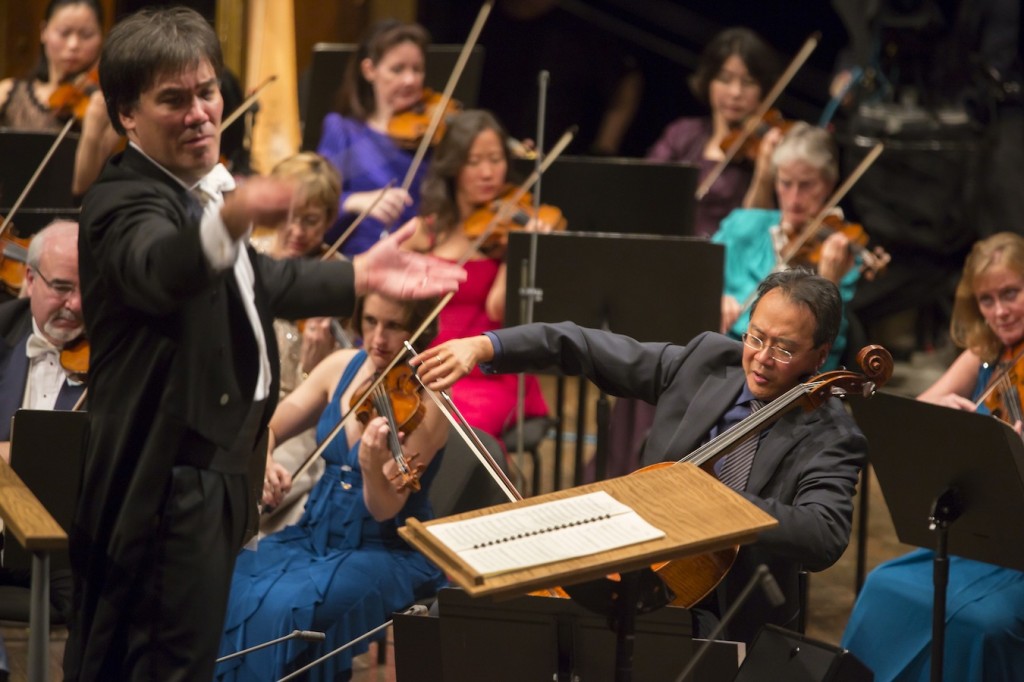Yo-Yo Ma opens Philharmonic season with a stirring performance

Yo-Yo Ma performed Golijov’s “Azul” with Alan Gilbert and the New York Philharmonic at the season-opening gala concert Wednesday at Avery Fisher Hall. Photo: Chris Lee
In his tenure to date with the New York Philharmonic, Alan Gilbert has consistently sought to make contemporary music a major part of his concert programming. He reiterated that mission on Wednesday, structuring the Philharmonic’s opening night gala concert around a 2006 work by Argentine composer Osvaldo Golijov.
Azul, was composed for Yo-Yo Ma, who gave it a stirring, invested Philharmonic premiere Wednesday night. It is an impressive and expressive work, cycling through a broad range of emotions, textures, and colors with sincerity and sentiment. Its instrumentation is certainly inventive, featuring a “hyper-accordion” (a modified accordion, played here by its creator Michael Ward-Bergeman) and percussion unusual to classical symphonic writing, including various drums, tambourines, and rattles from Africa, South America, and the Middle East. The main body of the piece, consisting of four movements (“Paz Sulfúrica,” “Silencio,” “Transit,” and “Yrushalem”), hangs together well.
Golijov’s voice is compelling, and in this piece he displays a varied palette, exploring different effects and modes. Formless without meandering, his writing is unapologetically tonal, at times employing melodic lines that sound downright Romantic. One particular transition, coming out of the pastoral “Silencio” and interrupting with stomps in the lower strings and seeming chaos in the violins, is especially effective.
Ma let his fingers get away from him at one point during an extended unaccompanied bariolage in “Transit” but, consummate professional that he is, he was unfazed and the music was scarcely diminished. Even in his momentary lapse his playing was haunting.
In the codas “Pulsar” and “Shooting Star,” we hear the entire orchestra lurching together towards the conclusion, a powerful effect that is diminished somewhat by a strange and contrived-sounding slowdown that uses recorded “power down” sound effects to underscore the point that this is the end. All codas are tacked on to some extent, but this ending felt like an unnecessary comment on a piece that could speak for itself.
The crowd loved it though, giving the performance an extended standing ovation. New York audiences have a reputation for stodginess, but Gilbert has demonstrated repeatedly that compelling performances of admirable new music can be invigorating for both performers and listeners.
Ma stayed on for three selections from Astor Piazzolla’s La serie del Ángel, in an Octavio Brunetti transcription specially commissioned for this performance. Much of Piazzolla’s work was devoted to revolutionizing the music of his native Argentina by drawing from other styles, culminating in the creation of his signature “nuevo tango.” Brunetti’s version calls for solo cello, piano, strings, and accordion (replacing the bandoneon in the original). In the first of the three, “Milonga del Ángel,” the accordion felt like an afterthought, as though the part had been reduced, but its role was increased and used to more effect in the driving, thrilling “La muerte del Ángel.” The last of the three, “Resurrección del Ángel,” is delightful and swooping in its orchestral form, and here Ma was at his most poetic.
Bookending the program was lighter Ravel fare—opening night, 20th-century fluff, but fluff nonetheless.
In Alborada del gracioso, the pizziciati in the first bars were overly forceful, but Gilbert led an interpretation that was witty and exuberant. It was not exactly a nuanced performance, but it displayed dynamic and textural variety.
To close, Gilbert and the Philharmonic conjured up some bombast in the ever-popular Boléro. The music is not terribly difficult for anyone involved (save the poor percussionist on snare duty), but it manages somehow to be more than the sum of its parts, a repetitive and predictable piece that nevertheless thrills as it builds towards its crashing finish. It practically conducts itself, though Gilbert certainly deserves credit for drawing disciplined playing and vibrant tone out of his orchestra.
The lights that shone on the bunting behind the stage changed colors throughout the performance, and the build to blood-red (probably intended to be “Philharmonic Red”) at the climax followed by a total blackout seemed tacky. But hey, it’s opening night—let the stage directors have their fun too.
The New York Philharmonic opens its subscription season at 8 p.m. tonight with the Symphonic Dances from West Side Story and soloist Yefim Bronfman in Tchaikovsky’s Piano Concerto No. 1. nyphil.org; 212-875-5656.
Eric C. Simpson is the Hilton Kramer Fellow at The New Criterion




Posted Jan 02, 2014 at 7:38 am by B.A.Dilger
“Azul” was not music, even in the classical sense. I was sadly disappointed that my time was wasted listening to a brilliant performer make noise.
Posted Jan 03, 2014 at 12:27 am by Kennette Harrison
Of course, Yo-yo Ma. But Azul stirred me as nothing has in years, of which I and my 90 year old companion have many. I wished, as I watched and listened to PBS on this second day of 2014, that Osvaldo Golijov could have seen my eyes tear with joy as we two here were overcome with something magically moving. When I heard Pavarotti live at his best voice, I experienced similar elation. Nothing else comparable. Thank you, Señor Osvaldo Golijov! I wish I had a recording.